On first glance, Pollard’s farm in Co Wexford looks like a typical dairy farm, but it’s not.
It’s a farm on a journey to self-sufficiency by 2023, meaning all feed will be grown on the farm.
Over the past number of years, fertiliser and animal remedy inputs have been reducing. Artificial fertiliser was all but gone this spring and so it made sense to apply to the organic farming scheme. Once the conversion period is up, the farm will hopefully supply milk to Glenisk.
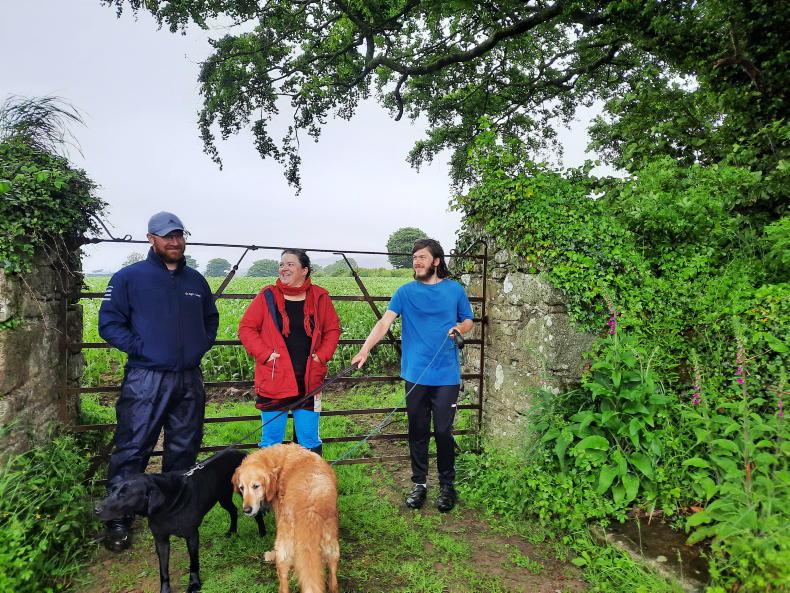
Kevin O’Hanlon, Marie Pascal Pollard and Nathan Pollard outside a crop of spring beans.
There are 160 cows currently grazing on a platform of 145ac. This platform is made up of grass and clover swards (50% of the platform), multispecies swards (25% of the platform) and perennial ryegrass swards (25% of the platform). The herd is mainly Holstein Friesian with Norwegian Red, and making its way in is the Fleckvieh breed. Also on the farm are 70 heifer calves and 46 maiden heifers.
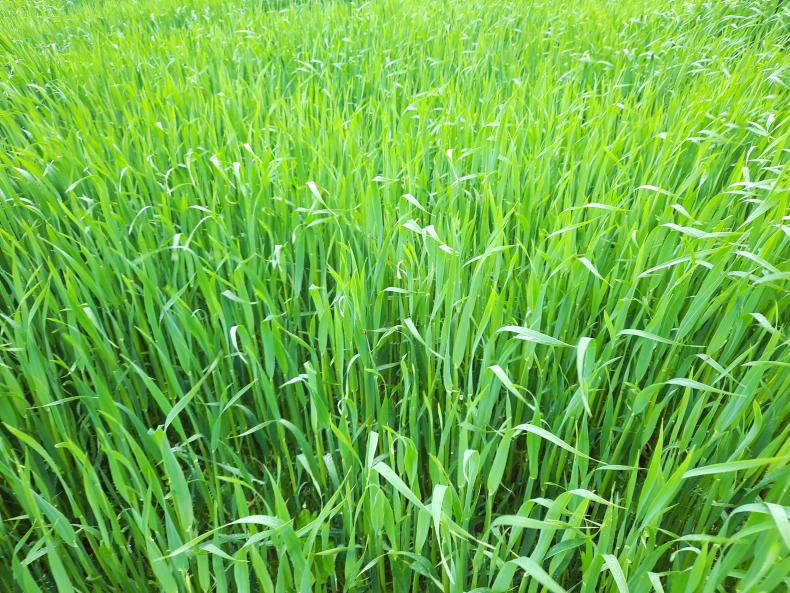
A crop of organic spring oats on the farm.
Kevin O’Hanlon is the farm manager and when the Irish Farmers Journal visited, the first person who greeted us was Marie Pascal Pollard, who owns the farm. The pair clearly work well together and have a shared vision of farming in as environmentally friendly a way as possible. Marie is conscious of avoiding feeding products like imported soya which can result in deforestation of the rainforests.
Marie’s husband John tragically passed away in a farm accident in 2015. His vision for the farm lives on through Marie and Kevin. He was talking about carbon footprints long before they were fashionable, Marie noted. Kevin worked alongside John for more than six years and all shared the same vision. Now Marie described how that vision is being added to and changing with the future of farming.
Solar panels and wind turbines are the first thing that catch your eye on the farm, with plans to be off the grid very shortly. As you make your way along the farm roadways, multispecies swards stand out. The farm is a partner farm of DLF seeds and has the added advantage of the company providing seed and advice on these swards.
Multispecies swards
The first of these swards were planted in April 2020 and plantain and chicory are the noticeable plants standing tall, while the white and red clover content is high and the remainder of the sward is perennial ryegrass.

A multispecies sward of plantain, chicory, red and white clover and perennial ryegrass left for silage.
All are well established and one paddock was left for silage to see how this works out. Most of the reseeds are established using minimum-tillage, but ploughing takes place where there is a weed problem.
With no artificial nitrogen being applied, there is a big focus on clover. Kevin adds clover seeds to the slurry tank when applying to paddocks which are low in clover. The practice definitely seems to be working. Seeds are trampled in by the cows and walking the fields clover content looked to be ranging between 15% and 40% across different paddocks.
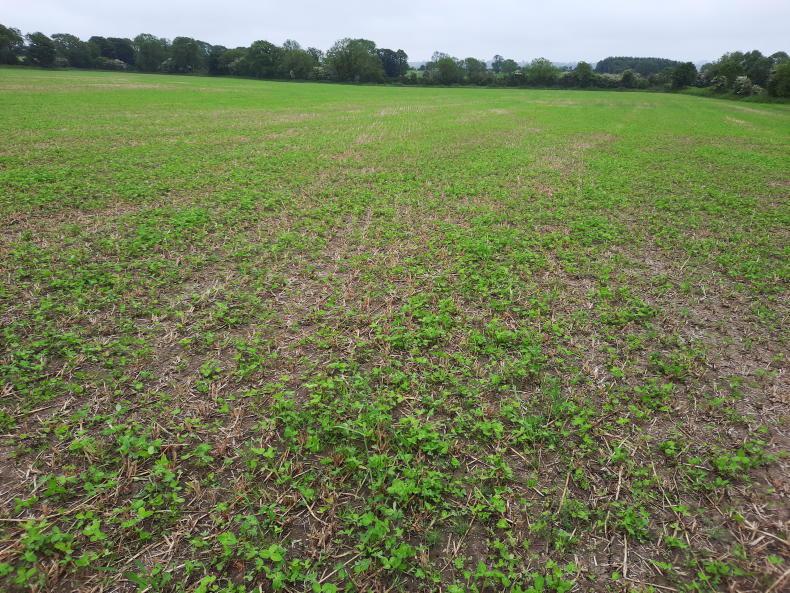
Red clover with Lucerne stitched in.
Further along the platform is a multispecies reseed where Lucerne was added to the mix. It was breaking through after a month in the seedbed.
Watery slurry is applied on every second round at 1,500 gallons/ac. Kevin allows the gutters of the shed to send water to the tanks. Some 1,500 gallons/ac of thick slurry will be applied to the second cut of silage.
Growing winter feed
It’s a very dry farm and cows are at grass for at least 310 days. They are generally out until the end of November and this year they went back out on 2 January. The herd is milking all year round, with 70% of cows calving in the spring and 30% calving in the autumn. As the farm is transitioning to organic, the herd will move to 100% autumn calving.
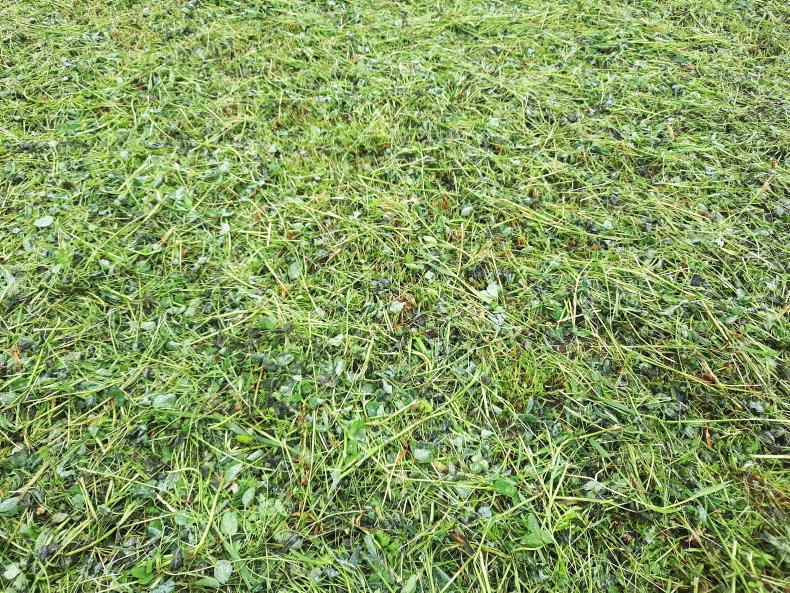
Red clover down for silage.
An average of 1,100kg of concentrates are being fed per cow per year. In 2019, average milk solids were at 620kg, while in 2020, after starting a transition to reduced inputs, solids were at 607kg. Up to the end of April solids were at 202kg.
At present a GM-free ration from Quinns of Baltinglass is being fed. From September on, the plan is to be feeding the farm’s own homegrown ration. This season spring beans, oats and barley were planted.
At present there is a lot of trial and error on the farm, but Marie noted that this is important and she has been happy to try new strategies on the farm. Partnering with DLF has also helped to take a chance on some things.
As we move to the out-farm, good crops of organic beans and oats greet us and further down the lane there was red clover silage on the ground. This was planted last September and it is hoped to get three cuts per year. This should provide significant protein to the diet. Grass silage will also be fed.
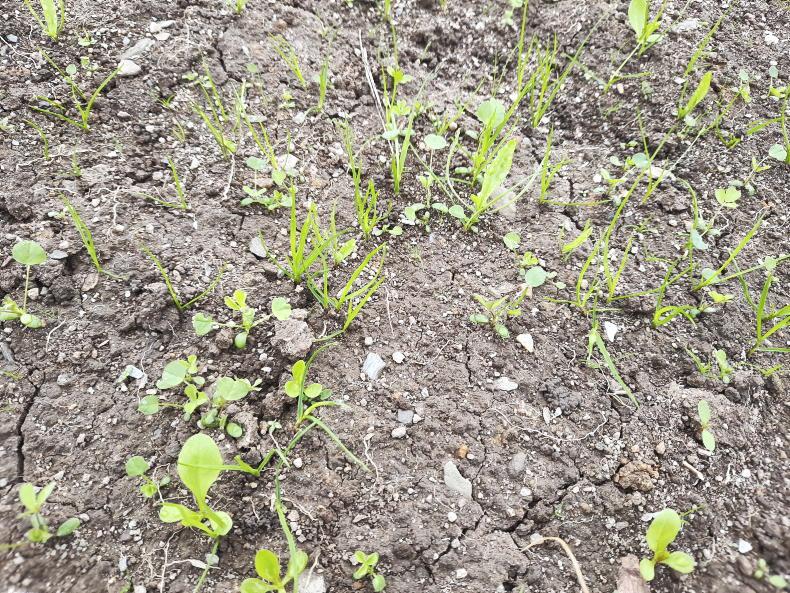
A newly reseeded sward which includes perennial ryegrass, plantain, chicory, red and white clover and Lucerne.
Above this field, forage rye was harvested for silage recently. This was undersown with red clover and once whole crop silage was taken off Kevin stitched in Lucerne (also known as alfalfa, which is a legume). Five weeks after establishment, the Lucerne was above ground. Spring barley was also planted with a grass crop this season and will be harvested for winter feed.

A crop of spring beans on the farm.
Kevin walks grass regularly and last week the cows had a comfortable 12 days of grass ahead of them and 30ac were mowed on the platform for silage. Almost four bales/ac were taken off.
Biodiversity
Aside from the range of species in the grass swards and numerous different crops on the farm, there is an oak plantation, as well as Sitka spruce forestry.
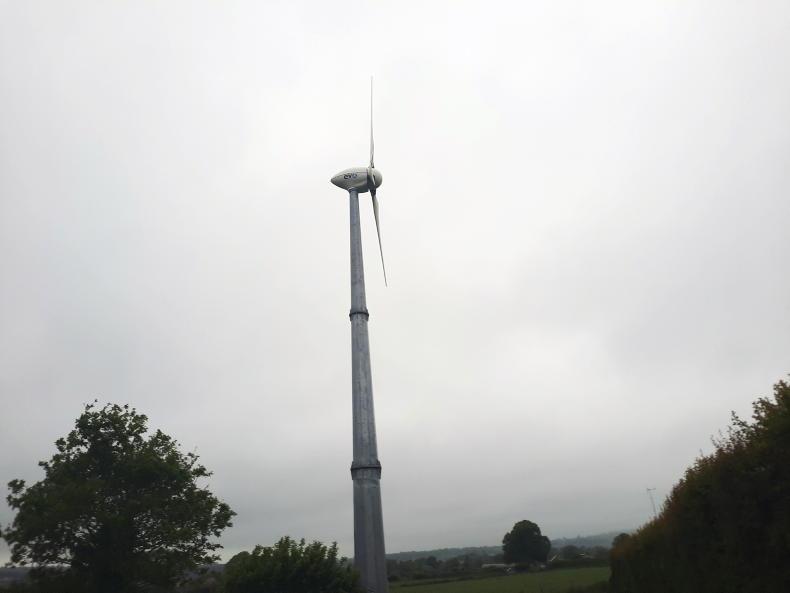
One of two wind turbines on the farm.
Looking around the paddocks, whitethorns were in bloom and there are many old hedgerows on the perimeters. Kevin said they will start a rotation on hedgerow trimming and allow trees to grow up every few metres.
This is certainly a farm doing things differently and preparing itself for some of the policy and legislation coming down the line. Kevin noted the savings made on fertiliser have helped with profits, but it’s clear that a huge amount of thought, time and effort goes into the new ideas and practices on the farm.
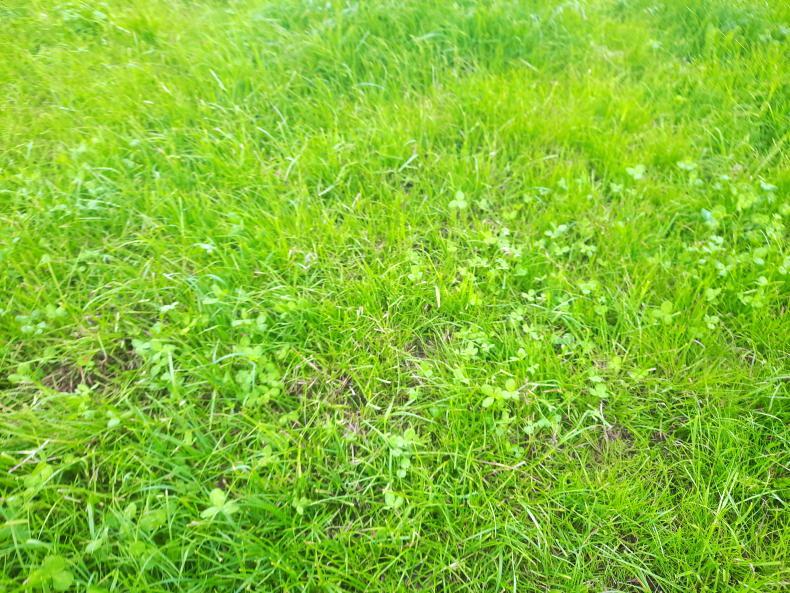
There is a high clover content in swards across the farm. It is a top priority without artificial fertiliser.
Work goes into building clover levels and this is clearly a key part of the fertiliser reduction strategy, but soils are in good condition in terms of phosphorus, potassium and lime already, which is an important start
While not everyone can grow their own feed there be opportunities to work with a local tillage farmer to source some forage or grain locally.
While self-sufficiency and zero artificial nitrogen is not for everyone, there are certainly positives and ideas to take from this farm’s journey.
On first glance, Pollard’s farm in Co Wexford looks like a typical dairy farm, but it’s not.
It’s a farm on a journey to self-sufficiency by 2023, meaning all feed will be grown on the farm.
Over the past number of years, fertiliser and animal remedy inputs have been reducing. Artificial fertiliser was all but gone this spring and so it made sense to apply to the organic farming scheme. Once the conversion period is up, the farm will hopefully supply milk to Glenisk.

Kevin O’Hanlon, Marie Pascal Pollard and Nathan Pollard outside a crop of spring beans.
There are 160 cows currently grazing on a platform of 145ac. This platform is made up of grass and clover swards (50% of the platform), multispecies swards (25% of the platform) and perennial ryegrass swards (25% of the platform). The herd is mainly Holstein Friesian with Norwegian Red, and making its way in is the Fleckvieh breed. Also on the farm are 70 heifer calves and 46 maiden heifers.

A crop of organic spring oats on the farm.
Kevin O’Hanlon is the farm manager and when the Irish Farmers Journal visited, the first person who greeted us was Marie Pascal Pollard, who owns the farm. The pair clearly work well together and have a shared vision of farming in as environmentally friendly a way as possible. Marie is conscious of avoiding feeding products like imported soya which can result in deforestation of the rainforests.
Marie’s husband John tragically passed away in a farm accident in 2015. His vision for the farm lives on through Marie and Kevin. He was talking about carbon footprints long before they were fashionable, Marie noted. Kevin worked alongside John for more than six years and all shared the same vision. Now Marie described how that vision is being added to and changing with the future of farming.
Solar panels and wind turbines are the first thing that catch your eye on the farm, with plans to be off the grid very shortly. As you make your way along the farm roadways, multispecies swards stand out. The farm is a partner farm of DLF seeds and has the added advantage of the company providing seed and advice on these swards.
Multispecies swards
The first of these swards were planted in April 2020 and plantain and chicory are the noticeable plants standing tall, while the white and red clover content is high and the remainder of the sward is perennial ryegrass.

A multispecies sward of plantain, chicory, red and white clover and perennial ryegrass left for silage.
All are well established and one paddock was left for silage to see how this works out. Most of the reseeds are established using minimum-tillage, but ploughing takes place where there is a weed problem.
With no artificial nitrogen being applied, there is a big focus on clover. Kevin adds clover seeds to the slurry tank when applying to paddocks which are low in clover. The practice definitely seems to be working. Seeds are trampled in by the cows and walking the fields clover content looked to be ranging between 15% and 40% across different paddocks.

Red clover with Lucerne stitched in.
Further along the platform is a multispecies reseed where Lucerne was added to the mix. It was breaking through after a month in the seedbed.
Watery slurry is applied on every second round at 1,500 gallons/ac. Kevin allows the gutters of the shed to send water to the tanks. Some 1,500 gallons/ac of thick slurry will be applied to the second cut of silage.
Growing winter feed
It’s a very dry farm and cows are at grass for at least 310 days. They are generally out until the end of November and this year they went back out on 2 January. The herd is milking all year round, with 70% of cows calving in the spring and 30% calving in the autumn. As the farm is transitioning to organic, the herd will move to 100% autumn calving.

Red clover down for silage.
An average of 1,100kg of concentrates are being fed per cow per year. In 2019, average milk solids were at 620kg, while in 2020, after starting a transition to reduced inputs, solids were at 607kg. Up to the end of April solids were at 202kg.
At present a GM-free ration from Quinns of Baltinglass is being fed. From September on, the plan is to be feeding the farm’s own homegrown ration. This season spring beans, oats and barley were planted.
At present there is a lot of trial and error on the farm, but Marie noted that this is important and she has been happy to try new strategies on the farm. Partnering with DLF has also helped to take a chance on some things.
As we move to the out-farm, good crops of organic beans and oats greet us and further down the lane there was red clover silage on the ground. This was planted last September and it is hoped to get three cuts per year. This should provide significant protein to the diet. Grass silage will also be fed.

A newly reseeded sward which includes perennial ryegrass, plantain, chicory, red and white clover and Lucerne.
Above this field, forage rye was harvested for silage recently. This was undersown with red clover and once whole crop silage was taken off Kevin stitched in Lucerne (also known as alfalfa, which is a legume). Five weeks after establishment, the Lucerne was above ground. Spring barley was also planted with a grass crop this season and will be harvested for winter feed.

A crop of spring beans on the farm.
Kevin walks grass regularly and last week the cows had a comfortable 12 days of grass ahead of them and 30ac were mowed on the platform for silage. Almost four bales/ac were taken off.
Biodiversity
Aside from the range of species in the grass swards and numerous different crops on the farm, there is an oak plantation, as well as Sitka spruce forestry.

One of two wind turbines on the farm.
Looking around the paddocks, whitethorns were in bloom and there are many old hedgerows on the perimeters. Kevin said they will start a rotation on hedgerow trimming and allow trees to grow up every few metres.
This is certainly a farm doing things differently and preparing itself for some of the policy and legislation coming down the line. Kevin noted the savings made on fertiliser have helped with profits, but it’s clear that a huge amount of thought, time and effort goes into the new ideas and practices on the farm.

There is a high clover content in swards across the farm. It is a top priority without artificial fertiliser.
Work goes into building clover levels and this is clearly a key part of the fertiliser reduction strategy, but soils are in good condition in terms of phosphorus, potassium and lime already, which is an important start
While not everyone can grow their own feed there be opportunities to work with a local tillage farmer to source some forage or grain locally.
While self-sufficiency and zero artificial nitrogen is not for everyone, there are certainly positives and ideas to take from this farm’s journey.















 This is a subscriber-only article
This is a subscriber-only article











SHARING OPTIONS: